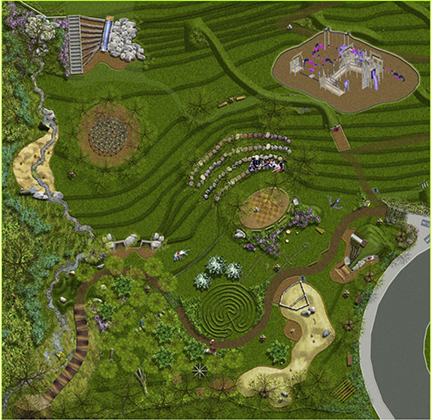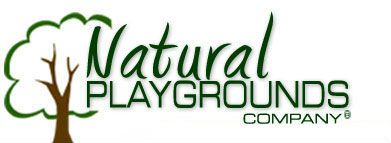By accepting you will be accessing a service provided by a third-party external to https://www.naturalplaygrounds.com/
What does a natural playground cost?
We always know there'll be a time during presentations to prospective clients when someone will ask "how much do natural playgrounds cost?"
I take a deep breath and say "That's a hard one, but if you give me a minute, I'll give you an answer."
It's hard because there are no direct comparisons. A few of the tangibles might be sort of comparable, but it's almost impossible to compare the intangibles. For instance, a slide is a slide, so the experience of actually going down a slide in a manufactured playground and going down a slide built into a hill in a natural playground will be pretty close. But it's really more complicated than that.
Overall
- They are the same initial investment as a traditional playground
- 10 times more play and learning elements
- Significantly higher play value
- Tailored to your budget
- Last longer
- Lower maintenance costs
Here's an example: a 35' long slide gives a great ride for kids of all ages, 5 years to 65 years. To achieve the proper slope for this long a slide, the ladder has to be 20' high. 20' is way off the ground. If kids try climbing the slide and fall off one side, they'll get hurt. If they fall off the ladder, they'll get hurt. Further, if they're afraid of climbing ladders, or are intimidated by height, they won't have a chance to even try the slide.
On the other hand, if this same slide is built into a hill, there is no ladder (so no one can fall off), there is no way a child can be intimidated by height, and there are no sides to fall off of, which makes the slide very safe. Further, if the access up the hill to the top of the slide is made challenging and fun (rock walls to climb, or interesting paths to follow), then children will find the whole experience more interesting and may therefore be more inclined to repeat it -- thus making them exercise more while they're learning more than just climbing up and sliding down. The actual cost of the slide for the natural playground will be far less, as the slide is simpler (no structure, no ladder, no ladder enclosure, no tube to keep kids from falling off), and there is no need for a fall zone all around the slide (it's just at the end).
On the other hand, you do need a hill in which to embed the slide...but the hill creates a great opportunity for numerous other activity elements: climbing walls, rock climbs, rope and post climbs, caves, other length slides, water falls, open tunnels, slopes for rolling and sledding, jumps, amphitheaters, and so on -- all of which can be built into the hill, all of which require no structures, and all of which are therefore less expensive.
Another Example
Just to make the point a bit further, let's look at a climbing wall. In a manufactured playground, a large climbing wall is usually free standing. Because it stands by itself, it's a destination activity, so a child makes a simple choice about it. "Do I want to try climbing this wall or not." There is no incentive to climb it, other than the fear of being left out, so if they don't want to climb it, they won't, and will just go do something else instead.
A climbing wall built into a hill is a whole different situation! We usually taper our walls to follow the slopes, so both the lower and higher parts of the wall appeal to different skill levels. But because there is exciting stuff happening on top of the hill, such as caves, king of the hill forts, expedition boulders, slopes to roll down, and lots of other things -- not the least of which is the view from the highest point on the playground -- a child has lots of incentive to learn how to climb the wall. It's no longer a simple destination activity that can be ignored. It's a fully engaging activity that involves more of the senses, more challenge, more self-motivation, more energy, more socializing, more learning, and more discovery.
Here's yet another way to think about it.
Recently, we were working on a design of a natural playground for an elementary school with an area of about 22,000 square feet in size -- close to a 1/2 acre.
We designed the entire area so that it was a wonderful blend of many distinct, very different, very wonderful play elements, everything from a rain garden, a labyrinth, an amphitheater, and a large sand play area, to a fairy village, a stream, a teepee village, caves, climbing elements, a slide, fruit trees, benches, a discovery path, and so on.
At the time, the landscape contractor estimated $100,000 to build this area.
We decided it would be an interesting exercise to see what $100,000 could buy in the way of equipment (which had to include its installation, the fall zone material, and borders to contain the fall zone).
if you look in the top right corner of the picture below, you will see that this equipment occupies only 3,000 square feet, which is only 15% of the entire 1/2 acre! it's visually unappealing, it's unchallenging, it's boring after a few tries, it's metal/plastic has a very high carbon footprint, it's not sustainable, and the injury statistics say that it's not safe.
Here's another interesting fact: to intrigue you: manufacturers always tout how many play activities their equipment has. To arrive at this number, they count each individual item as a separate play activity, so if there are 4 playshell traverses (all of which are the exact same item), the company considers these 4 play activities, or if there are 13 playpod pedestals, each pedestal is considered a play activity. This sample equipment in the top right corner is advertised as having 43 play activities.
With this same approach in mind, we counted all the individual rocks, steppingstones, posts on the post-walk, and so on, and this particular natural playground design, there are 430 such play activities -- 10 times!!! as many as the above equipment offered, and for the same price!! -- but carefully and thoughtfully spread out over the whole 22,000 square feet so kids are constantly moving around the entire site!
So comparing activities between natural and manufactured playgrounds is almost meaningless. Nevertheless, the below image shows the spatial comparison and also highlights the visual differences.

If you'd like help designing a natural playground that maximizes the potential of your outdoor space for play and learning activities, while providing your children connections to nature, please don't hesitate to contact us by phone 888-290-8405 or by This email address is being protected from spambots. You need JavaScript enabled to view it..

